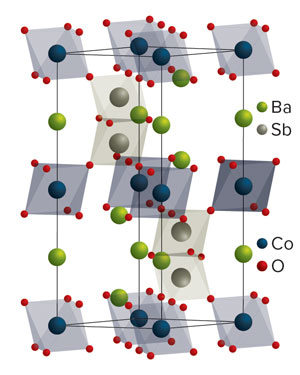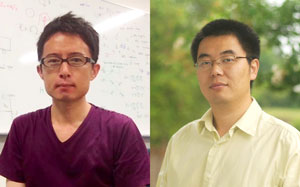Sep. 14, 2018 Research Highlight Physics / Astronomy
Quantum behavior of magnetic excitations revealed in antiferromagnet
Scientists use theory and experiment to explore the balance between wave and particle characteristics of magnetic excitations
 Figure 1: The chemical structure of the antiferromagnetic material barium cobalt antimonite. Modified from Ref. 1 and licensed under CC BY 4.0 © 2018 Y. Kamiya et al.
Figure 1: The chemical structure of the antiferromagnetic material barium cobalt antimonite. Modified from Ref. 1 and licensed under CC BY 4.0 © 2018 Y. Kamiya et al.
The unusual magnetic properties of an antiferromagnetic material, studied by RIKEN scientists, could guide the development of components for quantum computers and precision measurement devices1.
Many magnetic properties depend on the orientation of the electron spins in a material, since they possess intrinsic magnetic moments rather like miniature bar magnets. For example, everyday permanent magnets produce a magnetic field because most of their electronic spins (and hence their magnetic moments) are aligned in the same direction. In contrast, neighboring magnetic moments of antiferromagnetic materials tend to point in opposite directions, so that the material has no overall magnetization. However, the application of an external magnetic field can flip some of the electronic magnetic moments and magnetize the material.
In a collaborative study involving researchers from China and the USA, Yoshitomo Kamiya of Condensed Matter Theory Laboratory and his colleagues have now used a mixture of theory and experiment to probe the magnetic properties of an antiferromagnetic material called barium cobalt antimonate (Fig. 1).
Increasing the material’s magnetization created a spin pattern with magnetic excitations known as magnons. Their behavior can be described in two ways: one based on quantum theory and the other with its roots in classical physics. The quantum approach treats magnons as emergent particles, whereas the classical one regards them as waves.
“In spin wave theory, magnons are wave-like excitations, similar to sound waves propagating in a rigid medium,” says Kamiya.
 Yoshitomo Kamiya (left), Jie Ma of Shanghai Jiao Tong University, together with their co-workers, have studied the wave and particle characteristics of magnetic excitations called magnons. © 2018 RIKEN
Yoshitomo Kamiya (left), Jie Ma of Shanghai Jiao Tong University, together with their co-workers, have studied the wave and particle characteristics of magnetic excitations called magnons. © 2018 RIKEN
Previous experiments had found that magnons behaved in odd ways in this material in the absence of an external magnetic field. “Our goal was to narrow down the origin of this anomalous behavior,” says Kamiya.
The researchers studied magnons in barium cobalt antimonate at a third of its maximum possible magnetization, under a strong external field. They used neutron-scattering measurements to map the magnons’ behavior, and found that the magnons were well described by the semiclassical spin wave theory.
In the absence of an external magnetic field, however, magnons in the material are more likely to decay into ‘fractionalized particles’ called spinons, whose properties depend on quantum theory and which do not have a classical counterpart in spin wave theory. Fractionalized particles are so called because they carry a fraction of the magnetization unit.
“Our work is providing clear guiding principles for finding fractionalized excitations in real materials,” says Kamiya. “These excitations have the potential to replace classical technologies with quantum ones, which are rooted in the intrinsically quantum mechanical behavior of electrons in solids.”
Related contents
- Using spin current to convert mechanical vibrations into electricity
- New-wave spintronics comes to light
- Frustration produces a quantum playground
References
- 1. Kamiya, Y., Ge, L., Hong, T., Qiu, Y., Quintero-Castro, D. L., Lu, Z., Cao, H. B., Matsuda, M., Choi, E. S., Batista, C. D. et al. The nature of spin excitations in the one-third magnetization plateau phase of Ba3CoSb2O9. Nature Communications 9, 2666 (2018). doi: 10.1038/s41467-018-04914-1
